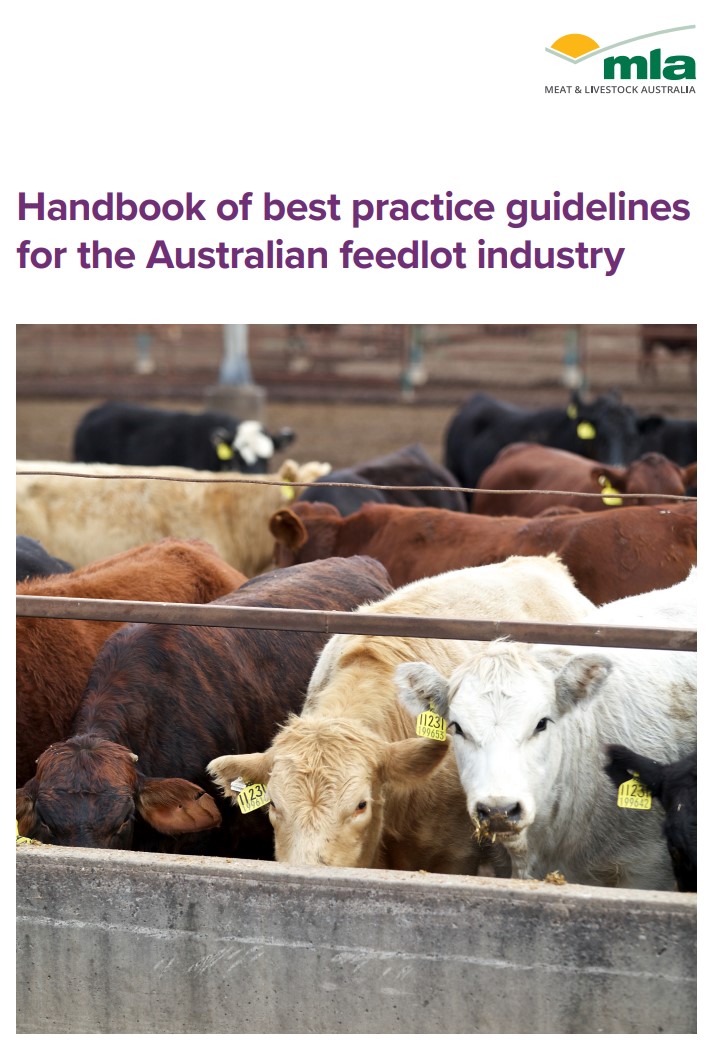 The Feedlot Best Management Practice (BMP) handbook is now available to Australian lot feeders.
The Feedlot Best Management Practice (BMP) handbook is now available to Australian lot feeders.
A handbook of best practice guidelines for the Australian feedlot industry has been developed by the Australian Lot Feeders’ Association (ALFA) and MLA as a practical guide for lot feeders and their employees.
Development of the handbook was led by the Feedlot Industry Accreditation Committee (FLIAC) chair Jim Cudmore, who has extensive experience with feedlot industry initiatives, projects and strategy, and is known as an influential beef industry champion.
Here, Jim outlines the guide, why it was developed, the importance of best management practices, and why feedlots should consider the adoption of these practices.
What is the guide?
The Feedlot Best Management Practice (BMP) handbook is a tool to assist feedlot operators in setting guidelines, identifying outcomes and key operational procedures for best practice standards in alignment with the current National Feedlot Accreditation Scheme (NFAS).
The document is not a substitute for the Quality Management System in feedlots, but a practical guide for feedlot operators to consider in their operational and management programs.
The aim of the handbook is to provide a concise guide and reference document for feedlot operators and their teams to promote improved practices in the Australian feedlot industry. It can also be used to assist in the training of people, the development of in-house procedures and to review requirements for feedlots over time.
Why was it developed?
The development of this handbook stems from the lot feeding industry’s dedication to continual improvement. The best management practice guidelines are in alignment with the principles of the NFAS and encourage an all-of-industry approach to operate cattle feedlots above the current minimum standards of the NFAS.
As the peak industry council representing grainfed beef producers, ALFA has the responsibility to develop policy in a manner which reflects best practice standards and to develop information that enhances best practice behaviours in feedlot operations.
The handbook is part of a suite of initiatives to assist the feedlot industry in collectively establishing improved practices and performance.
What does it include?
The best management practice handbook presents guidelines for feedlot operators to consider in addressing key operational procedures across the spectrum of activities undertaken on a beef cattle feedlot. The guidelines are formulated based on specific outcomes being targeted in specific timeframes. Feedlot operators can use the checklist-type approach to formulate activities and actions to address those desired outcomes specific to their enterprise.
The handbook also contains references to additional industry information and fact sheets.
It’s been developed in alignment with the principles of the NFAS Standards:
- Livestock management 2. Quality management system
- Food safety management 4. Environmental management
- Product integrity 6. Administration.
Why is best management practice important?
The best management practice handbook aims to assist feedlot operators to improve the performance of their enterprises. The modules were designed to present the best available information and management principles at above the minimum standards for the NFAS.
The purpose of the NFAS is to provide a Quality System for beef feedlots that will impact positively on grainfed beef integrity, quality and acceptability, and for which lot feeders maintain responsibility. The NFAS Standards describe the processes by which the feedlot industry – as a pro-active self-regulated sector – has agreed to operate, so as to demonstrate its commitment to animal welfare, environment, meat quality and food safety.
As such, the NFAS Standards are designed to:
- protect the reputation and integrity of NFAS,
- enhance the integrity of product described as grain fed,
- address food safety issues,
- maintain the image of feedlots held by the community, particularly relating to environmental impact and animal welfare issues, and
- protect the integrity of the AUS-MEAT Language.
The NFAS Standards comprise five (5) standard Modules, with each Module containing one (1) or more Elements which describe the required Outcomes that an accredited feedlot must meet to maintain certification in the program.
The NFAS has demonstrated that self-regulation is an effective tool for meeting community, market and government expectations for intensive agriculture. During this time, the industry has operated in an array of environmental and market conditions and continued to grow to become a significant and integral part of the Australian beef industry (1994 inception of NFAS national feedlot capacity was 460,000 head – at the end of 2021 national capacity stands at 1.45m head).
The major initiative to the above success and the orderly growth and development of the Australian beef cattle feedlot industry, is largely attributable to the sound principles developed and included in the industry’s accreditation procedures encompassed in the NFAS. Also, the excellent cooperation between industry and government agencies to effect sound planning and accreditation procedures has enabled the feedlot industry to establish an excellent reputation in agriculture in relation to quality assurance, environmental management and animal welfare issues.
However, customers and consumers will continue to become more discerning about the way food is produced. Consequently, being able to demonstrate sound environmentally sustainable production methods; animal wellbeing and welfare safeguards; hygienic, safe food; and an industry commitment to continual improvement being undertaken and verified, will be crucial to meeting future community expectations.
Why should feedlots adopt the best management practices outlined in this guide?
The feedlot industry has enterprises on a scale from new entry to those who have been operational since the 1960s, in climatically and geographically different locations with different cattle populations that are targeting a vast array of market outcomes.
The handbook is providing guidance to all feedlot operators, those accredited in the NFAS and those who have not yet transitioned to the program, on potential actions and activities that can be considered to increase the overall level of performance in the industry.
The positive outcomes from feedlots adopting a BMP focus will encourage future community and customer support that can underpin the future growth of the industry.
Download the handbook








